
We are in a new era of Steam Next Fest (SNF). In the Fall of 2024 and again in February 2025, Valve changed the SNF algorithm slightly to potentially give more visibility to smaller titles by distributing equal visibility on all games. Did it work? Let’s find out.
The data in this report comes from a survey I sent out in the days following the February 2025 SNF. I got 208 responses which sets a record! With 2244 games participating in SNF we surveyed about 9.2% of all games that were in the festival. I am blown away. If you contributed data, thank you so much. This truly helps us understand the current state of marketing on Steam.
TLDR; Results
How many wishlists will you earn during Steam Next Fest? Here is a chart of every single game and the number of wishlists they earned during the festival. Each bar represents a different game. The color correlates to their tier (see below).
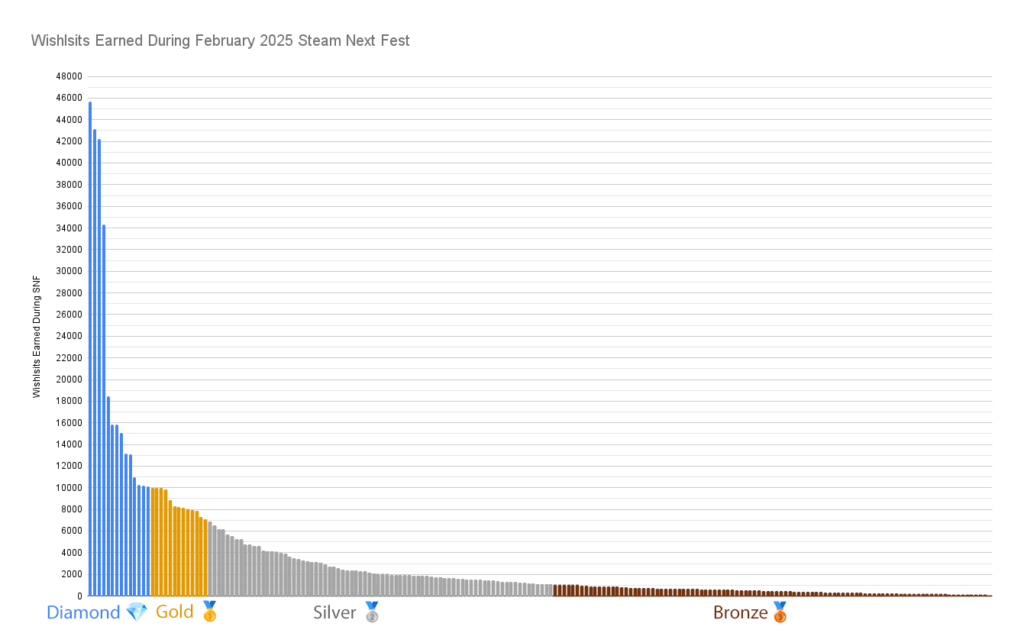
To keep things consistent with my other benchmarks I broke the number of wishlists earned for each game into 4 tiers.
Number of wishlists earned by each game during Steam Next Fest.
| Tier | Wishlists earned during February 2025 Steam Next Fest |
| 💎 Diamond | 10,000+ |
| 🥇 Gold | 7000-9,999 |
| 🥈Silver | 1000-6,999 |
| 🥉 Bronze | 0-999 |
For the rest of this blog post, these tiers are based on how many wishlists that were earned during the next fest. Note that it doesn’t refer to the total number of wishlists they had before or how much money they made.
Second side note: There isn’t a Steam algorithm reason why I separated them into these buckets. When you look at the above chart, you will notice that the diamond tier games really take off compared to all the others; those games have some special *MAGIC*. I also set the break between Gold and Silver at 7000-9999 because 7000 is typically the number of wishlists you need to get into Popular Upcoming at launch and that is pretty impressive if you can get that number of wishlists in a single festival.
It takes wishlists to earn wishlists
When I was compiling the data I noticed that all the games in the Diamond and Gold Tier already had a ton of wishlists before the next fest. So I created this scatter plot to see how pronounced this was.
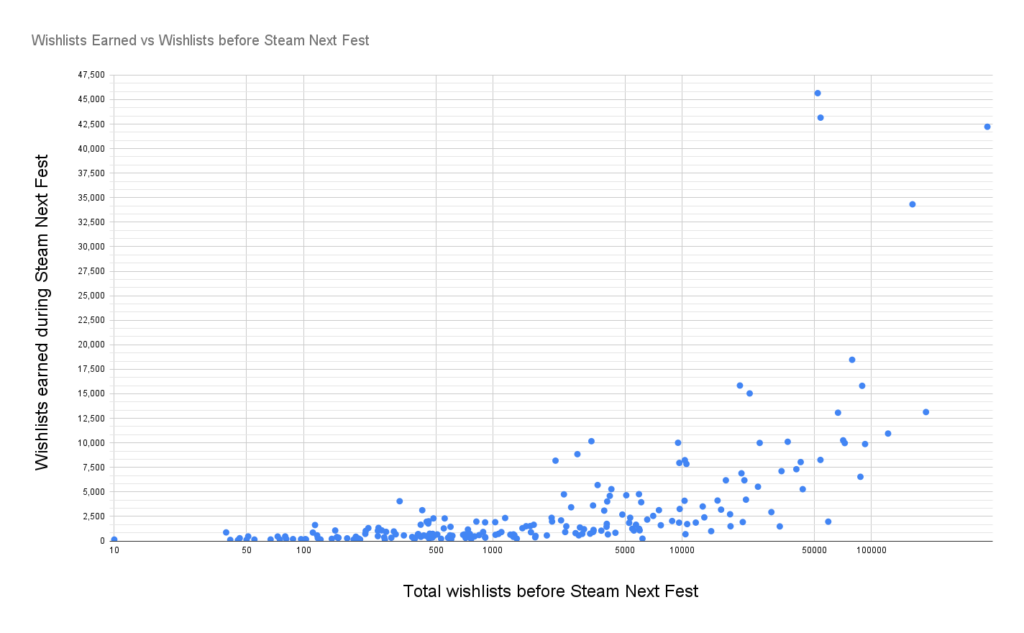
Note the logarithmic scale of “Total Wishlists Before” X axis.
You really start to see how the wishlists a game earns takes off for games that have 2000+ wishlists before Steam Next Fest. I have highlighted it here in red.
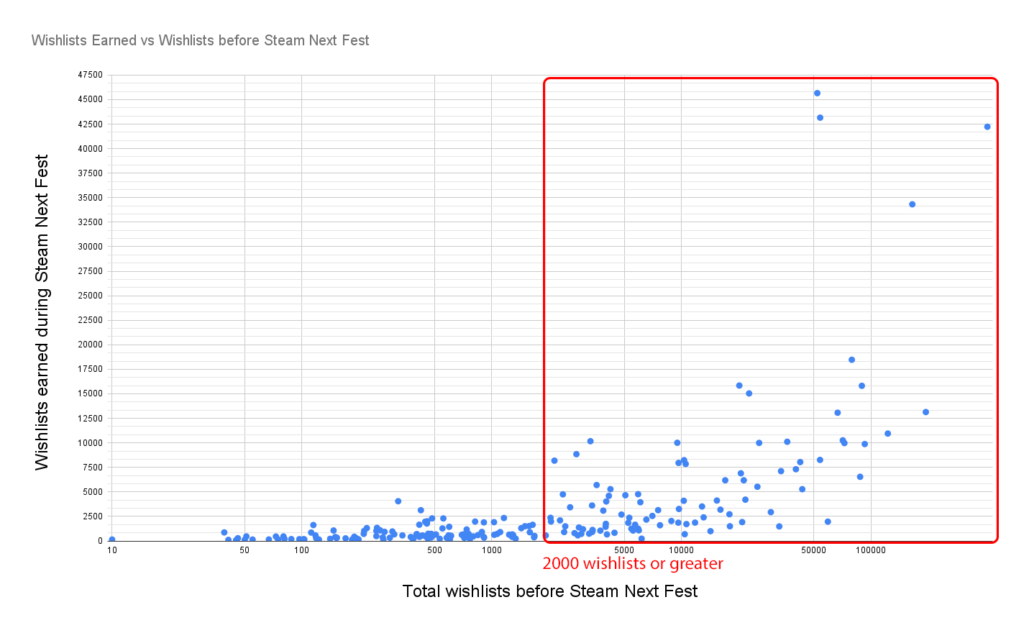
It really seems like you don’t get any sort of lift from Steam Next Fest unless you have at least 2000 wishlists. I don’t think this is an algorithm thing, it just seems that 2000 correlates with having some interest, some skills at marketing. You just need that validation pre Steam Next Fest.
Advice:
A lot of indie devs tell me they want to get into Steam next fest because they want to “Kick off Momentum.” The theory is kind of like “priming the pump” or “kickstarting a motorcycle”: try to get a bunch of wishlists in SNF at the start of your game’s marketing journey so you will get “momentum” and keep pushing your game up.
But this chart clearly shows how much of a mistake this approach can be. The games that do best in Steam Next Fest are the ones that already have momentum. Games starting at 0 don’t get much visibility. SNF is not where you get your momentum, it is where you capitalize on it.
How do I say this more clearly: DON’T LAUNCH YOUR DEMO WITH NEXT FEST.
I have actually had developers ask if you can launch a demo outside of SNF. You can do whatever you want! But, Next Fest is the grand finale of your demo. It is when you say goodbye to it before you launch your game.
How much can I earn based on my game’s wishlists?
Again, if you go into Next Fest with very few wishlists, you won’t get many. I know causation isn’t correlation, but I just wanted to show you exactly how stark this is.
I made the following chart to say “If we entered the June Next Fest, how many wishlists can I hope to earn based on our current wishlist count?” To use this chart, find the number of wishlists you have on the far left and then move across the columns to see the range of possible outcomes.
| Wishlists before SNF (Median from survey) | Average earned | Fewest earned | 30th percentile earned | Median earned | 70th percentile earned | Most Earned | Median percentage increase over total |
| 0-999 (307) | 705 🥉 | 74 🥉 | 303 🥉 | 462 🥉 | 720 🥉 | 4,048 🥈 | 150% |
| 1000-9,999 (3386) | 2367 🥈 | 231 🥉 | 962 🥉 | 1,513 🥈 | 2,359 🥈 | 10,168🥇 | 45% |
| 10,000 – 99,999 (22,766) | 8499 🥇 | 684 🥉 | 3,415 🥈 | 6,360 🥈 | 8,745🥇 | 45,655💎 | 28% |
| 100,000+ (179,788) | 25,000 💎 | 10,948 💎 | 12,919💎 | 23,731💎 | 35,112💎 | 42,230 💎 | 13% |
If you go in with fewer than 1000 wishlists, there were 0 games that broke out of that tier. None of them magically became Diamond tier. Games with 1000-9999 mostly stayed within the bronze to silver tier.
This is why I recommend doing the last Steam Next Fest before you launch. The games with the most wishlists also earn the most wishlists. If you manage to get 100K wishlists you have the best chance at earning the most possible wishlists.
Also, don’t launch your demo and then immediately enter Next Fest. Use several other festivals to beta-test your demo. Polish, refine, improve. Enter into smaller festivals (which I track at Howtomarketagame.com/festivals.)
With a few exceptions, the tier you went into next fest with was the tier you left next fest with.
What won at Next Fest?
If you wanted to earn diamond tier wishlists but don’t have a ton of wishlists there was one game that beat the odds. The game with the lowest starting wishlists that rose to diamond status was Backrooms Cleanup Crew. The game is a co-op horror that went in with just over 3,000 wishlists and earned just over 10,000 by the end of the festival. That boost came from the popularity of horror, co-op, and backrooms. Again, Steam looooooooves horror.
The game that earned the most wishlists during SNF was spooky-themed crafty buildy Do No Harm at 45655 new wishlists on top of the existing 52102 it had going in.
I talked to a member of the team to see if they had any advice on how they did it.
“Overall, up until Jan 29th when we released our announcement trailer on GameTrailers, we had very weak results. But with the trailer + PR outreach + Demo going live on Feb 4th, we started seeing very nice results.” They also said that they did run some ads to help support their existing SNF performance.
The game launched shortly after SNF and already has a very healthy 435 reviews.
What genres won Next Fest?
What were the genres of the Diamond tier games?
- Horror x2
- Strategy x2
- Point-and-click adventure x2 (amazing!)
- Management x2
- Farming
- Walking Simulator
- Autobattler
- Vampire Survivors-like
- NSFW
- Simulation
- Puzzle
Again, I am not making this up, Steam likes Crafty-buildy-strategy-simulationy games (and also Horror).
But what is the deal with Point and Click? I thought you said that is a terrible genre!?! It is important to look at what types they are:
Both of these games are sequels to existing successful series. This is the 4th Beholder game!
Normally the median for Point & Click games are very very low but if you find success, fans will come back to play your sequels.
Separate or same page?
As with Fall 2024, Valve gives the option to publish your demo on a separate page that gets reviews or host it on the same page as the main game.
Here are the numbers
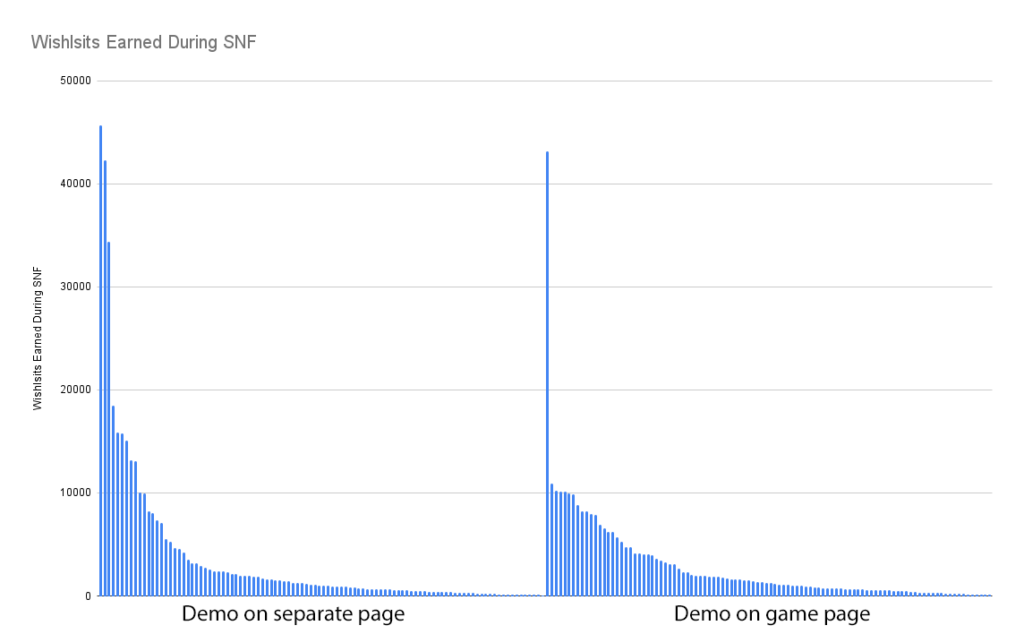
| Percentage of games using this option | Median Wishlists Earned | Average Wishlists Earned | |
| Demo on separate page | 50% | 1040 | 3652.176471 |
| Demo on main game page | 50% | 1300.5 | 2897 |
Exactly half of all games did separate demo, half of games did demo on main page.
The average is higher for separate page. The median is higher for demo on main page.
I don’t think your choice affects the performance of your game. HOWEVER, a separate Steam page for your demo allows for reviews and it is much more important to get the feedback from real users (not your goofy friends) before you launch your game.
So my advice: SEPARATE STEAM PAGE. Don’t be afraid. Listen to your players. If things turn negative, you can always pull your separate demo Steam page
Number of Demo Plays
This fact breaks brains: the vast majority of players during SNF will wishlist your game without playing it and that is totally fine.
Players don’t fall in love with you and your game and that is totally fine.
Players don’t rationally test drive games to decide if the game meets their 5 criteria of value-per-dollar before wishlisting and eventually buying it and that is totally fine.
I know this because at the end of every Next Fest Valve publishes the following stats:
- # of people who played your demo but didn’t wishlist.
- # of people who played the demo AND wishlisted it
- Total number of wishlists.
The number of people who play and wishlist is surprisingly low. The best case is 32%. The more typical case is somewhere around 17%. Here is the full breakdown from the survey:
| Wishlists earned during SNF | Median Num of Demo PLAYED | Median PLAYED & WISHLISTED | Percent who Wishlisted & Played VS just played | Median wishlists earned during Next Fest | Percent of wishlists that came without playing |
| 💎 Diamond Tier (Earned 10K+) | 15,039 | 4,834 | 32% | 15037 | 68% |
| 🥇 Gold Tier(Earned 7000-9,999) | 10,436 | 1539.5 | 14.7% | 8208 | 81% |
| 🥈 Silver Tier(Earned 1000-6999) | 1854.5 | 363 | 19.5% | 1972 | 81% |
| 🥉 Bronze Tier(Earned 0-999) | 303 | 54 | 17.8% | 455 | 88% |
Look at that last column. MOST people wishlist games without playing it. And that is totally fine.
This is what breaks people’s brains. They say “Well if 80% of people wishlist my game without playing, why do I spend so much time making a demo? Demo’s are actually bad for games!”
That is the wrong way to think about it. Demos unlock visibility. Demos allow you to get to the front page of Steam Next Fest in sections like “Most Wishlisted” or “Recommended.” If you didn’t have a demo, you wouldn’t appear in that section or in Steam Next Fest.
Even top earning diamond tier games that will probably go on to make millions of dollars have very low player to wishlist ratios.
Demos allow content creators to play the game so that their audience will know about it.
Maybe players are interested in the game but don’t have time to play it during that 1 week period.
Maybe players love your game so much they don’t want to be spoiled by playing the demo. Or maybe they know they are going to buy it so why waste time playing a stretch of the game they will probably play again during the full version.
I also suspect that there are “super players” who try hundreds of demos and then tell their friends about the best ones. Those friends wishlist the recommended games without playing the demo.
All of these different player behaviors still require a demo but there isn’t necessarily a clear funnel of PLAY > WISHLIST > BUY. Sometimes it is SEE ON FRONT PAGE > WISHLIST > BUY. Sometimes it is SEE ON FRONT PAGE > REMEMBER > BUY at launch (no wishlisting).
I think developers assume that future customers are SOOOOO excited for their game that they will consume every bit of news, drop their current game, and play your game the moment it becomes available, and join your discord. In reality, most players just go “eh this looks cool, I will buy it and might play it after I am done with the game I am playing now.” And then never play it.
Simon Carless wrote about this in this blog post. Most people’s Steam library is made up of games they have never played.
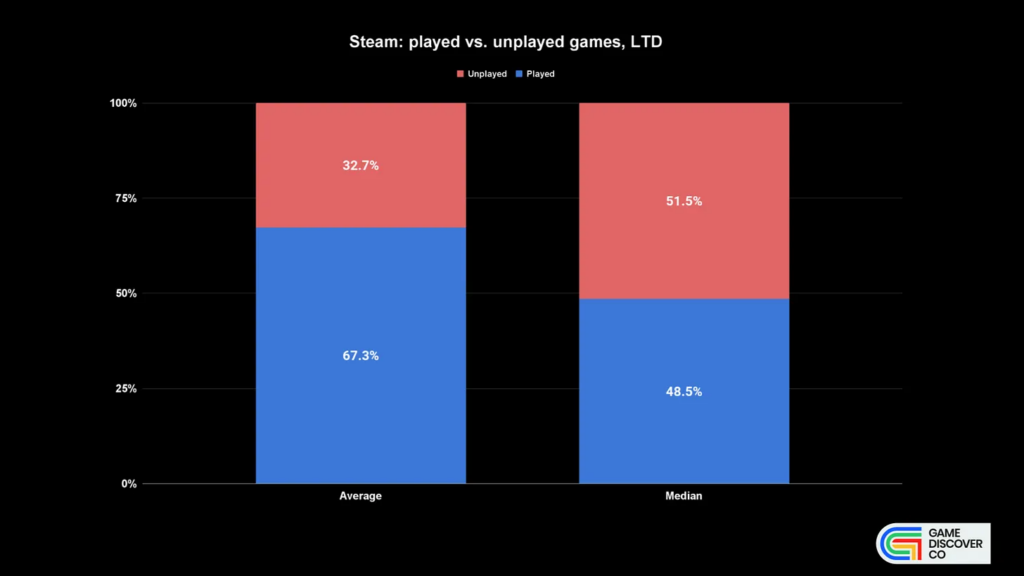
Games are an aspirational hobby. People buy games because they WANT to identify as someone who plays those types of games. But they might not have the time or the actual will to.
So yes, you need to make a demo, even if the vast majority of people will never play it.
First 2 Days vs after
One of the big changes in the current iteration of Steam Next Fest is that Valve gives ALL games some visibility at the start.
I asked developers for the number of impressions that come directly from “SALES PAGE” during each day of SNF. These impressions are only driven by SNF and not some other Steam page like the “More Like This” section. It also doesn’t include external traffic from Youtube or social media. With this we can see how the Nextfest page drives traffic..
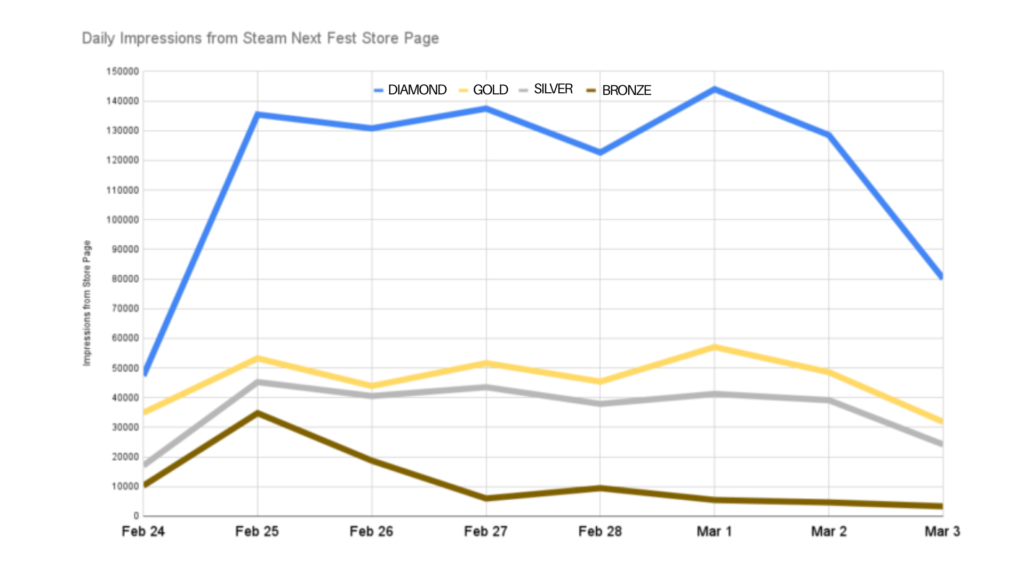
Note: the reason March 3rd drops dramatically is because Steam Next Fest ended halfway through that day.
Based on the graph you can see that, yes, in Day 1 and 2, all games get more and more traffic. It was so unusual to see this much exposure to weird bronze tier games that it freaked out some Journalists who thought Steam was getting flooded by AI-powered game generators. Read this article on Aftermath.site where I tried to calm them down and explain how it’s just low effort games that will eventually be hidden.
Sure enough, on the 3rd day, the Steam algorithm smothered those AI generated shovelware games (as well as some other bronze tier games made by responsible devs). Don’t freak out about the coming AI flood.
At the same time, diamond Tier games just rocketed up to the top of visibility earning almost 3x the visibility that the next gold tier down gets.
A lot of this is probably driven by the “top wishlisted” and “most played demo” charts. But still, it is amazing how much they get.
Total Impressions
| Wishlists earned during SNF | Total impressions of median game in this tier |
| 💎 Diamond Tier (Earned 10K+) | 926,369 |
| 🥇 Gold Tier(Earned 7000-9,999) | 366,593 |
| 🥈 Silver Tier(Earned 1000-6999) | 288,883 |
| 🥉 Bronze Tier(Earned 0-999) | 92,8450 |
What to make of this? I really think games have a “spirit” to them. Devs ask “How do I get more visibility for my game.” The limiting factor is not “exposure.” Valve gives you visibility; it’s what you do with it that is important. Note how close the day 1 impression numbers are for the Silver and Bronze tier games. But then shoppers say “nah, this game doesn’t look good to me” and bronze numbers fall off a cliff. Similarly, Gold and Diamond tier games start Day 1 with about the same amount exposure, but there is something *MAGIC* about those diamond games and Steam responds by almost TRIPLING the impressions they hand out on day 2.
Summary
I applaud Valve for adding features to make Steam more egalitarian. However, you have to understand what Steam Next Fest is. It does not drastically change the course of a game. Next Fest doesn’t really uncover hidden gems. It basically amplifies the numbers that games are already getting. There are few surprises.
So what are my recommendations:
- Get your demo out months and months before next fest
- Enter other festivals (Next Fest should be your last)
- Try to enter with at least 2000 wishlists, it seems to correlate with more impressive results.
- Push hard for marketing on your first 2 days, hopefully you end up on the positive side of the algorithm.
- Put your demo on a separate page that can collect reviews.
- Don’t freak out when people wishlist without playing your demo.
Final thoughts on Steam Next Fest
SNF isn’t necessarily your best opportunity to earn wishlists. There are many other festivals every month that have fewer games in it and are more closely aligned to your game’s genre. You can find them on my community’s festival tracker (howtomarketagame.com/festivals).
The reason I document SNF so much is because every single developer on Steam gets to participate. That means every single developer asks me about it and when to do it, and how to get the most visibility.
Steam Next Fest is the default option. Everyone is prompted to do it. But, the most effective marketing techniques don’t come from the prompts that every developer has access to. If it is default, it isn’t going to be as impactful. The best things come from actions that you initiate such as entering festivals, reaching out to streamers, and getting influencers to cover your game on social media. You need to do it not wait for someone to ask you if you want to participate.